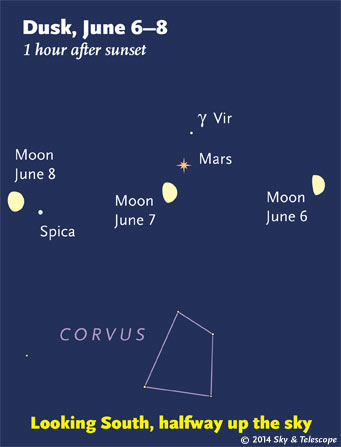
Friday, June 6
Look left of the Moon this evening for Mars, then Spica, as shown at right.
With June under way, the Big Dipper is swinging around after dark to hang down by its handle high in the northwest. The middle star of its handle is Mizar, with tiny little Alcor right next to it. On which side of Mizar should you look for Alcor? As always, on the side toward Vega! Which is now shining in the east-northeast.
Saturday, June 7
The waxing gibbous Moon shines near Mars this evening. Look just above Mars for fainter Gamma (γ) Virginis (Porrima). Spica shines farther to their their left, as shown here.
Sunday, June 8
Now the gibbous Moon pairs up with Spica.
Monday, June 9
The Moon is part of a four-object lineup tonight: with Saturn to its left and Spica and Mars to its right.
With summer not far off, can you still catch Procyon very low in the twilight? You may need binoculars. It's 17° lower left of Jupiter. For how many more days can you follow it? The first day that a star becomes completely invisible in the afterglow of sunset is called its heliacal setting.
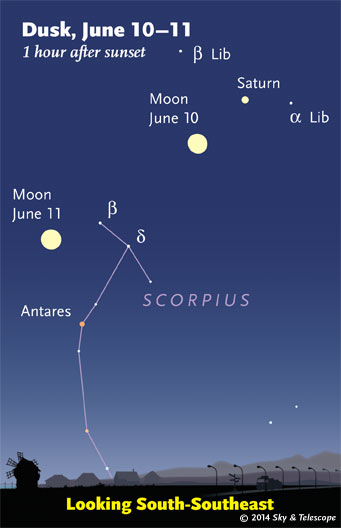
Tuesday, June 10
Now the waxing gibbous Moon is lower left of Saturn at nightfall. Look farther to the Moon's lower left for Antares and the other stars of upper Scorpius, as shown here.
For southernmost Africa, the Moon occults (covers) Saturn around 19 hours Universal Time.
Wednesday, June 11
Now it's Antares's turn to shine near the Moon. As evening grows late, it swings straight below the Moon (for North America).
Thursday, June 12
Full Moon (exact at 12:11 a.m. June 13th EDT). The Moon shines in the dim legs of the constellation Ophiuchus. Look for Antares well to its right.
Friday, June 13
Vega is the brightest star shining in the east after dusk. It's currently the top star of the big Summer Triangle. The brightest star to Vega's lower left is Deneb. Look farther to Vega's lower right for Altair. The Summer Triangle will climb higher in early evening all through the summer, to pose highest overhead at dusk when fall begins.
Saturday, June 14
Mars and Spica arrest your eye in the southwest just after dark this week. Spot brighter Arcturus high above them. Half as far below them is the four-star pattern of Corvus, the Crow.
Want to become a better astronomer? Learn your way around the constellations. They're the key to locating everything fainter and deeper to hunt with binoculars or a telescope.
This is an outdoor nature hobby. For an easy-to-use constellation guide covering the whole evening sky, use the big monthly map in the center of each issue of Sky & Telescope, the essential guide to astronomy. Or download our free Getting Started in Astronomy booklet (which only has bimonthly maps).

Once you get a telescope, to put it to good use you'll need a detailed, large-scale sky atlas (set of charts). The standards are the little Pocket Sky Atlas, which shows stars to magnitude 7.6; the larger and deeper Sky Atlas 2000.0 (stars to magnitude 8.5); and once you know your way around, the even larger Uranometria 2000.0 (stars to magnitude 9.75). And read how to use sky charts with a telescope.
You'll also want a good deep-sky guidebook, such as Sue French's Deep-Sky Wonders collection (which includes its own charts), Sky Atlas 2000.0 Companion by Strong and Sinnott, the bigger Night Sky Observer's Guide by Kepple and Sanner, or the beloved if dated Burnham's Celestial Handbook.
Can a computerized telescope replace charts? Not for beginners, I don't think, and not on mounts and tripods that are less than top-quality mechanically (able to point with better than 0.2° repeatability, which means fairly heavy and expensive). As Terence Dickinson and Alan Dyer say in their Backyard Astronomer's Guide, "A full appreciation of the universe cannot come without developing the skills to find things in the sky and understanding how the sky works. This knowledge comes only by spending time under the stars with star maps in hand."
This Week's Planet Roundup
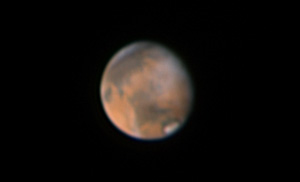
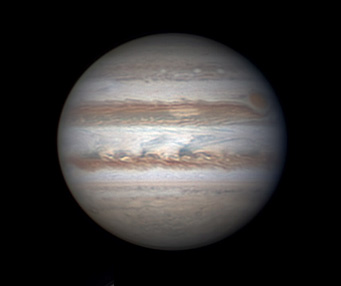
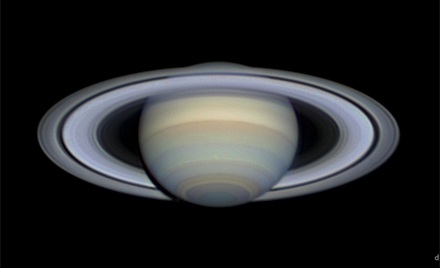
Venus (magnitude –3.9) remains quite low in the east during dawn.
Mars (magnitude –0.4, in Virgo) shines high in the south-southwest in late twilight. Upper right of it by about 3° is 3rd-magnitude Gamma Virginis (Porrima). About four times farther to Mars's lower left sparkles Spica. Mars sets in the west around 2 a.m. daylight saving time.
In a telescope, Mars's gibbous disk is 11 arcseconds tall and shrinking. See the Mars map and observing guide in the March Sky & Telescope, page 50. Use our Mars Profiler to find which side of the planet will be facing Earth when you plan to look.
Jupiter (magnitude –1.9, in Gemini) shines low in the west-northwest in twilight and sets around nightfall. Look for Pollux and Castor to its upper right.
Saturn (magnitude +0.2, in Libra) glows in the southeast to south during evening. The wide binocular double star Alpha Librae glimmers 3° or 4° to Saturn's lower right. They fit well within a typical binocular's field of view.
Look for Antares and the head of Scorpius well to Saturn's lower left.
It a telescope Saturn's globe is 18 arcseconds wide, and its rings are tilted 22° from our line of sight. Use our SaturnMoons app to find and identify Saturn's various satellites at any time and date. A 6-inch scope will show four or five of them: Titan, Rhea, Dione, Tethys, and Iapetus.
Uranus, in Pisces, is low in the east just before dawn begins.
Neptune, in Aquarius, is up in the southeast before the first light of dawn. Use our finder charts for Uranus and Neptune in 2014.
----------------------------------
All descriptions that relate to your horizon — including the words up, down, right, and left — are written for the world's mid-northern latitudes. Descriptions that also depend on longitude (mainly Moon positions) are for North America.
Eastern Daylight Time (EDT) is Universal Time (UT, UTC, or GMT) minus 4 hours.
 19
19
Comments
mary beth
June 8, 2014 at 3:33 pm
Just wanted to say how much I enjoy and appreciate Sky at a Glance! I've been a faithful reader since 2003 and have learned so much from just this one site. I love not only the very interesting information, but the fun little extras about seasons etc, and the depictions of how things are going to line up. I have shared so much knowledge with others and have gotten friends very interested in the night sky as well. Thank you producing such a useful and enjoyable column!
You must be logged in to post a comment.
David Dunn
June 9, 2014 at 3:34 pm
I agree, it's been a very useful webpage for me and my students. It always reminds me of what is up in the sky and has those interesting tidbits about the constellations and seasons.
You must be logged in to post a comment.
David Dunn
June 9, 2014 at 3:35 pm
Plus a nice recap of the planets which often wonderful picture from amateurs.
You must be logged in to post a comment.
mary beth
June 9, 2014 at 11:26 pm
Definitely! The Archived columns are nice too! It's fun to recall certain astronomical events since they can be so magical! I planned a week in Galveston this September based on how the night skies would look over the Gulf :).
You must be logged in to post a comment.
David Dunn
June 10, 2014 at 3:39 pm
Yes, this year has been good for our solar system. Jupiter has dominated the first 5 months, now Mars and Saturn have the spotlight. We've even had a good chance to see Vesta and Ceres together in binoculars. Up next we'll have two eclipses in October.
The late summer sky is always a treat - going up to the Sierras to see the Milky Way is quite inspiring.
You must be logged in to post a comment.
mary beth
June 10, 2014 at 7:55 pm
We have a rare June front that cleared our skies. I can't wait to see the planets tonight! Your view must be amazing from the mountains! I love Late Summer stargazing too, plus all the other changes in nature that come. I didn't know about the two eclipses, thank you for sharing! Enjoy the Strawberry Moon (and Antares) this Thursday!
You must be logged in to post a comment.
David Dunn
June 11, 2014 at 3:41 pm
Yes, the views are great. In the late Summer/early Fall we take our classes up there to view the sky (it's nice to have frequent clear skies during that time of the year). Most students are quite impressed. One of my classes gets to photograph the sky and they get some wonderful pictures of the Milky Way. Someday, I'd like to venture to Black Rock, Nevada where the skies are truly dark!
I've been enjoying the moon travels across the sky and shall enjoy the Strawberry Moon tomorrow. I hope you get to see the planets last night ...
You must be logged in to post a comment.
mary beth
June 11, 2014 at 6:13 pm
Your students are very fortunate! Might be the only time in their lives they get to see these things! I have been scheduling outdoor activities every evening so i can enjoy the wondrous show! The ISS has made a few flyovers lately so that added to the production. Mars is interesting, so very due South! I suppose Jupiter will be leaving us at some point later this summer? Trying to enjoy it and The Twins while they're here. I love Scorpio so it's exciting to see it climb higher each night. I'd rather tell time that way than by clocks or calendars. What's the moon view for you? Hope it's clear and unobstructed!
You must be logged in to post a comment.
David Dunn
June 11, 2014 at 6:28 pm
Yes, the moon is no problem! Jupiter will be leaving us soon, but I've noticed the motion of Jupiter over the past 5 months. It was directly below Castor and Pollux for much of the winter forming an isosceles triangle with then , but now it's moved eastward and the triangle look quite different. I've also notice Mars's motion in Virgo go from near Spica to Porrima as it's was going retrograde. Now it's on its eastward passage back towards Spica and an eventual (but no so close) rendezvous with Saturn in late August.
I like Scorpius too - though your view is probably better from Galveston as it further south than I am.
You must be logged in to post a comment.
mary beth
June 11, 2014 at 6:15 pm
Ps - going to check out Black Rock right now!! Sounds beautiful, night or day!
You must be logged in to post a comment.
David Dunn
June 11, 2014 at 6:30 pm
The Black Rock Area is pretty isolated - not only famous for great observing but also high altitude model rocket launches.
You must be logged in to post a comment.
mary beth
June 11, 2014 at 11:55 pm
I'm glad you mentioned Porrima. I had never seen that star until this year, when it piqued my curiosity since it was so close to Mars. Is it also called Arich? I'm confused...my Star Chart App calls it Arich. Is it because it's a binary star?
Moon was gorgeous here - 'hanging in a blue twilight' (Stole that from a Ken Oak lyric) with Antares sparkling like a Spessartine Garnet below. Hope you saw both!
I'm glad we will have Saturn and Mars around a lot longer, and hopefully they'll be in one eye shot.
Black Rock sounds like a perfect place to experience the nature and the elements. Be quite an adventure to spend an entire year there documenting the Spindle of Necessity.
You must be logged in to post a comment.
David Dunn
June 12, 2014 at 1:58 am
Yes, I see alternative names for Porrima, including Arith and Antevorta. Since these names are given by people who only visually looked at the stars, it probably has nothing to do with it being a double star (Porrima can only be seen as a double through a telescope).
Antares looks good below the nearly full moon. 'Antares' actually means the rival of Mars - due to its red color, though I like the comparison to a Spessartine Garnet. (I also like the borrowing of the line from "Summer's Kiss" to describe the Moon appearance in the twilight sky).
You must be logged in to post a comment.
mary beth
June 12, 2014 at 12:35 pm
I didn't think about the ancient people not being able to see it as a double star...heck, I can't either lol! But what does amaze me is it seems that across the globe, there was an uncommunicated agreement on the constellations as far as what their outline appears to be. I suppose in a dark sky, the higher magnitude stars stood out very well? Yet I incline to think it would be more difficult to distinguish because of the sheer number of stars they were able to see. Also I assume most skies were very dark, but I also wonder whether there were some places darker than others even back then...?
Glad you know Ken Oak! He played a small live show here in Houston a few years back, and mentioned that he wrote that song in Galveston! Surprised and delighted me since it was already one of my favorite songs! Have you seen him perform out West?
You must be logged in to post a comment.
David Dunn
June 12, 2014 at 2:19 pm
LOL I have to confess that I don't know Ken Oak, I looked up the song on youTube - very pleasant song he sings and I like the 'hanging in the blue twilight' metaphor he used.
The Ancients probably saw down to mag 6 or so as it was Hipparchus who defined the system over 2300 years ago. I've heard though there are places that can see fainter than 6.0 with just the eye. Higher elevations will allow better seeing.
Have you been to the Texas star party? Some of the better skies in the country can be found in Western Texas...
You must be logged in to post a comment.
mary beth
June 12, 2014 at 3:26 pm
6th Magnitude??? WOW! I'm lucky to see First!! I would rather have that than television for sure! The beauty and dynamics of the procession of stars amazes and captivates me night after night. My kind of "Reality Show'!
I've been to Fort Davis and love it but haven't attended a star party. It was beautiful there, dawn, hot afternoons, and especially night. Have you been there, seen the Marfa lights? I have not seen them. It's definitely the best place to be in Texas. No humidity either, the big downfall of Houston. I suppose it's similar to where you live, a high desert? You must truly enjoy your situation :)!
I might take a full moon flight tonight - I'm friends with several people who have small private planes. We keep a telescope at the hangar. Weather permitting we might go up about 7:30. Unfortunately it's getting cloudy here though.
I'm glad you found the song and liked it! Tonight's song (lol) is "Waiting for the Moon to Rise" by Belle & Sebastian! Hope you enjoy - its real pretty!
You must be logged in to post a comment.
David Dunn
June 12, 2014 at 6:05 pm
Actually, I live in the Central Valley and am susceptible to lots light pollution, though when walk outside at night I can glimpse 3rd to 4th magnitude stars. But I'm not to far away from the Sierras which one can see down to 5th. But it is low humidity and no clouds during the summer (for the most part).
Full Moon Flight! That sounds great! The ground and clouds must look great lit up by the moon.
I've not been to Texas before... I'll make sure to check out "Waiting for the Moon to Rise".
You must be logged in to post a comment.
mary beth
June 13, 2014 at 11:03 am
At least you're close to dark skies! Fort Davis is 9 hours away from Houston.
It was too stormy too fly but when the clouds began to break the rainbowed moon shone beautifully! I could see Mars and eventually Saturn. I love when the moon has a halo. So it wasn't the evening I thought, but as always it was a sight to see! How was your viewing?
I hope they post the next Sky at a Glance today! I love to have the information on Friday :)!
Have a great start to the weekend!
You must be logged in to post a comment.
David Dunn
June 13, 2014 at 2:43 pm
My view of the Moon was good in very clear skies. The Full Moon always stands out in the night sky!
Yes, the new Sky at a Glance is here!
You must be logged in to post a comment.
You must be logged in to post a comment.